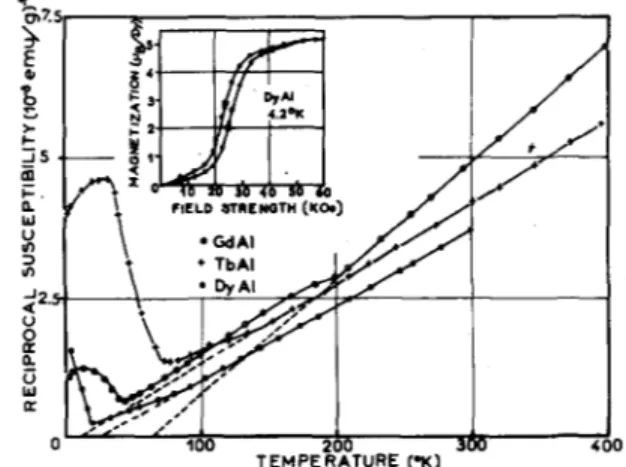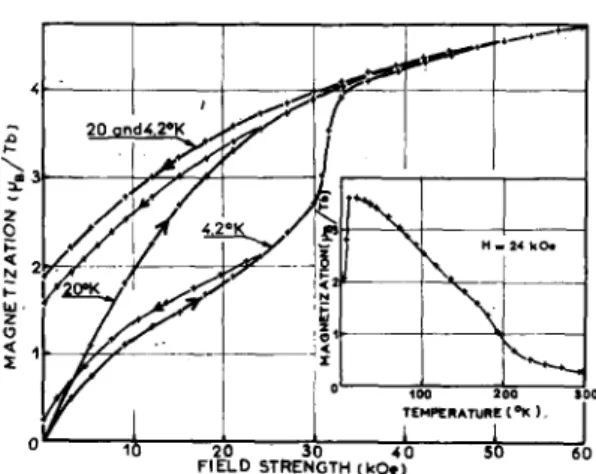HAL Id: hal-01660402
https://hal.archives-ouvertes.fr/hal-01660402
Submitted on 10 Dec 2017
HAL is a multi-disciplinary open access
archive for the deposit and dissemination of
sci-entific research documents, whether they are
pub-lished or not. The documents may come from
teaching and research institutions in France or
abroad, or from public or private research centers.
L’archive ouverte pluridisciplinaire HAL, est
destinée au dépôt et à la diffusion de documents
scientifiques de niveau recherche, publiés ou non,
émanant des établissements d’enseignement et de
recherche français ou étrangers, des laboratoires
publics ou privés.
Magnetic Properties of Some Rare Earth-Aluminum
Alloys
B. Barbara, C. Bècle, R. Lemaire, R. Pauthenet
To cite this version:
B. Barbara, C. Bècle, R. Lemaire, R. Pauthenet. Magnetic Properties of Some Rare Earth-Aluminum
Alloys. Journal of Applied Physics, American Institute of Physics, 1968, 39 (2), pp.1084 - 1085.
�10.1063/1.1656172�. �hal-01660402�
Magnetic Properties of Some Rare EarthAluminum Alloys
B. Barbara, C. Bècle, R. Lemaire, and R. PauthenetCitation: J. Appl. Phys. 39, 1084 (1968); doi: 10.1063/1.1656172 View online: http://dx.doi.org/10.1063/1.1656172
View Table of Contents: http://jap.aip.org/resource/1/JAPIAU/v39/i2 Published by the American Institute of Physics.
Additional information on J. Appl. Phys.
Journal Homepage: http://jap.aip.org/
Journal Information: http://jap.aip.org/about/about_the_journal Top downloads: http://jap.aip.org/features/most_downloaded Information for Authors: http://jap.aip.org/authors
JOURNAL OF APPLIED PHYSICS VOLUME 39, NUMBER 2 1 FEBRUARY 1968
Intermetallic Compounds
R. STREET AND
J.
E. GOLDMAN,Chairmen
Magnetic Properties of Some Rare Earth-Aluminum Alloys
B. BARBARA, C. BECLE, R. LEMAIRE, AND R. PAUTHENET
Laboratoire d'Electrostatique et de Physique du Metal, C.N.R.S., Grenoble, France
The RAl alloys are orthorhombic; the structure can be described with a trigonal motif similar to a half-cell of CsCI. The ~Al2 alloys are tetragonal. The magnetic properties of the RAl alloys, where R is any rare earth from Ce to Tm, and those of the RaAl2 alloys, with R passing from Gd to Tm, have been measured in fields up to 25 kOe or 60 kOe and at temperatures between 1.4° and 4OQoK. The RAI alloys, with R from Pr to Tb, order antiferromagnetically at temperature between 200K (PrAl) and 72°K (ThAI); the magnetic configuration of TbAl has been studied by neutron diffraction; HoAl is ferromagnetic with a Curie point at 26°K; DyAI, ErAl and TmAI exhibit metamagnetism at 4.2°K. GdaAl2 is ferromagnetic with a Curie point at 282°K, close to that of Gd; DyaAI2 shows an antiferromagnetic transition near 200K in zero field and metamagnetic behavior induced by a field below this temperature; its Curie point is 76°K. All compounds exhibit a Curie-Weiss behavior above their transition points, with a paramagnetic moment close to that of the corresponding free tripositive rare earth ions.
The rare earth-aluminum phase diagramsl generally
present five intermetallic compounds. The magnetic
properties of the RA12,2 RAla 3 and some RAI
com-pounds4 (where R is a rare earth metal) have already
been determined. We have concerned ourselves with those of the RAI and RaAl2 compounds. They are
pre-S7.5'r---~---r---'
~
CI>t
::,100 20 400
TEMPERATURE ("K)
FIG. 1. Reciprocal susceptibility-temperature behavior of GdAl, TbAI, and DyAI. Magnetization-field strength behavior of DyAI at 4.2°K.
pared by melting the required proportions of the ele-ments in a high-frequency levitation furnace. We have
J K. H. J. Buschow and J. H. N. Van Vucht, Z. Metallk. 57,
162 (1966).
2 H. J. Williams, J. H. Wernick, E. A. Nesbitt, and R. Sherwood,
J. Phys. Soc. Japan, Suppl. B-1 17,91 (1962).
a K. H. J. Buschow and J. F. Fast, Z. Phys. Chem. SO, 1 (1966) .
• F. Kissel and W. E. Wallace, J. Less-Common Metals 11, 417 (1966) .
studied only compounds which were found free from all other phases by x-ray examination. The magnetizations
are measured using the extraction method, in fields H
up to 2S kOe or 60 kOe and at temperatures ranging
from 1.40
to 4OOoK.
RAl COMPOUNDS
The crystal structures of the RAI compounds belong to two types. The first type,5 CeAI, crystallizes in the
TABLE 1. Experimental results for RAl compounds.
Compound CeAI PrAl NdAl GdAI TbAl DyAI HoAl ErAl TmAl 26 ON (OK) 9 20 29 42 72 20 13 10 (Jp (OK) M,(/J.B/R) 4 2.34 11 3.58 -4 3.53 64 8.15 10 10.0 25 10.6 17 10.7 23 9.65 -2 7.70
Cmcm group; LaAI and slowly cooled PrAl is isotypic
with it. The second type,6 DyAl, crystallizes in the Pbcm group; the compounds from neodymium up to thulium, with the exception of europium, are isotypic with it. These structures are both formed from the same motifs: aluminum chains and trigonal prisms showing simi-larities with a half-cell of CsCI; only the arrangement of these motifs differs. The magnetic results obtained with CeAI and PrAI are in good agreement with those
& C. Becle and R. Lemaire, Compt. Rend. 2MB, 887 (1967).
• C. BecIe and R. Lemaire, Compt. Rend. 2MB, 543 (1967).
1084
MAGNETIC PROPERTIES OF SOME RARE EARTH-A! ALLOYS 1085
reported by Kissel and Wallace,4 however, the
para-magnetic Curie points 8p that we have determined are
higher. NdAl, GdAI and TbAI are antiferromagnetic. DyAI exhibits a metamagnetic behavior below its order temperature (Fig. 1). HoAI has a spontaneous magnetization at low temperature, however at 4.2°K a field of 70 kOe is not sufficient to saturate it, a law of
approach in 1/ H gives a saturation magnetization of
6.2 ,uB/HoAI. ErAI and TmAl are metamagnetic below the Neel temperature. At high temperature all the compounds follow a Curie-Weiss law. The effective
moment Me in Bohr magnetons, deduced from the
Curie constant is in good agreement with that of the free R3+ ion (Table I). For numerous compounds, at low temperature, the variation of the reciprocal suscep-tibility no longer follows a Curie-Weiss law (Fig. 1). This difference cannot be attributed to crystal field effects, since it is maximum for GdAI. But neutron
diffraction studies7 of TbAI show at 1l00K a
short-range magnetic order. Below the Neel temperature of TbAI the antiferromagnetic arrangement of the mo-ments is not collinear; it is closely related to the exist-· ence of the trigonal prisms formed by the rare earth atoms. In fact it results from a compromise between anisotropic exchange interactions and a magnetocrystal-line anisotropy exerted along two different axes.
.Q
...
~3r---~~~~----~f r---~----~--~
FIG. 2. Magnetization-field. strength behavior at 4.20 and
200K and temperature variation of magnetization at 24 kOe of TbaAb.
7 C. Bede, R. Lemaire, and E. PartM (to be published).
TABLE II. Experimental results for RaAl2 compounds.
Compound Oc (OK) ON (OK) 0, (OK) 0" (OK) M.(p.B/R)
GdaAb 282 285 8.2 TbaAb 203 11 125 9.6 DYaAl2 76 20 31 10.8 HosAl2 33 11 10 10.9 EraAb 9 -3 9.6 TmaAb 3 -10 7.8 RaA12 COMPOUNDS
The RaAb compounds crystallizeS in the P~nm
group, their structure can be generated from rare earth chains and aluminum centered trigonal rare earth prisms. GdaAb is ferromagnetic with a Curie temperature 8e at 282°K, its absolute saturation
magnetization is 7.1 /JoB per gadolinium atom. TbaAl2
exhibits a ferromagnetic behavior from a transition temperature 8,= lOOK to the Curie point (203°K), below lOOK the magnetization decreases rapidly if measured in fields lower than 30 kOe; in the higher fields, it is practically the same as it is at 200K (Fig. 2). DyaA12 and HoaAb have magnetic behavior similar to that of TbaA12. The temperature of the different transi-tions are listed in Table II. EraAb and TmaAb have Neel temperature at 9° and 3°K, respectively below these temperatures they are metamagnetic. At high temperature, all compounds follow a Curie-Weiss law; the effective magnetic moment of the rare earth atoms corresponds to that of the tripositive free ion.
Neutron-diffraction studies of TbaA12 showed that, from 10° to
203°K, the terbium magnetic moments are parallel to one another; in a zero field, at 4.2°K, the moments are no longer collinear and exhibit a resultant which is not nil. As a conclusion, GdaAb is typically ferromagnetic but when the rare earth spin decreases and that its orbital moment increases, the compounds exhibit an antiferromagnetic behavior more and more accentuated at low temperature and which seems due to crystal-field effects.
8 N. C. Baenziger and J. J. Hegenbarth, Acta Cryst. 17, 620
(1964).

